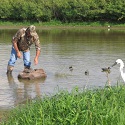 The past ten years have meant a significant change for waterfowlers. The migration of geese and ducks changed and hunters had to adjust. The huge flocks of geese that once flowed into the southern Illinois refuges for the winter have diminished. Birds still come but they are fewer and smarter. Ducks that did not stay long in the past are now flowing into grain fields and staying for the entire season. They once moved further south once the geese arrived.
The past ten years have meant a significant change for waterfowlers. The migration of geese and ducks changed and hunters had to adjust. The huge flocks of geese that once flowed into the southern Illinois refuges for the winter have diminished. Birds still come but they are fewer and smarter. Ducks that did not stay long in the past are now flowing into grain fields and staying for the entire season. They once moved further south once the geese arrived.
Hunters now combine an awareness of the habitat and technological advances with hunting opportunities open to the public.
Many hunters seek both geese and ducks over flooded grain fields. They place goose pits on the edge of the fields and floating duck blinds out in the water.
Communication between guides and hunter as well as between hunters is important. Sometimes misunderstandings happen when it is one person’s turn to shoot and everyone does not get the message. Regardless, hearing protection is important to prevent hearing damage from muzzle blasts. Especially useful are electronic ear muffs that protect from muzzle blasts yet allow one to hear anyone talking. They are part of the technology for satisfying waterfowl hunting.
Today many of the birds hunted are local birds whereas a few years ago they were many more migrators. The locals are quickly educated as to the location of refuge areas. They quickly learn where hunting pits and clubs are located and avoid them.
Ducks present their own problem. As individual species are usually only present for a month or so, the hunters have to learn their locations and flight patterns quickly. Continue – https://dongasaway.wordpress.com/2015/09/29/waterfowl-hunters-are-adjusting-their-tactics/
